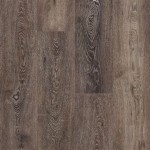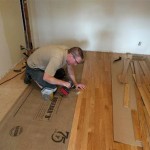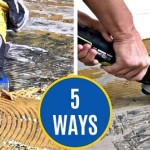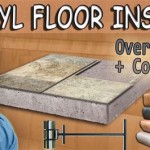How To Remove Double-Sided Carpet Tape From Your Floor
Double-sided carpet tape is a useful adhesive for securing rugs, carpets, and runners to various floor surfaces. Its strength and ability to prevent slippage make it a popular choice for both temporary and semi-permanent installations. However, removing double-sided carpet tape can often present a challenge, leaving behind sticky residue and potentially damaging the flooring if not approached correctly. The success of the removal process hinges on understanding the type of flooring, the type of adhesive used in the tape, and employing the appropriate removal techniques.
Different types of flooring require different approaches. Hardwood floors, for instance, demand gentler methods to avoid scratching or damaging the finish. Tile floors are generally more resilient but can still be susceptible to damage from harsh chemicals. Laminate flooring, being a composite material, requires methods that avoid moisture penetration and swelling. Vinyl flooring is relatively durable but may discolor or become damaged by aggressive solvents. Therefore, correctly identifying the flooring is the first crucial step in the removal process.
The type of adhesive in the double-sided tape also plays a significant role. Some tapes use acrylic-based adhesives, which tend to be more solvent-sensitive. Others use rubber-based adhesives, which can be more resistant and leave behind a tougher, stickier residue. Knowing the type of tape used initially can help in selecting the most effective removal agent and technique.
Before embarking on any removal process, it is always recommended to test the chosen method in an inconspicuous area of the floor. This allows observation of the potential effects on the floor's finish or material without causing visible damage. This precautionary step can save significant time and money in the long run by preventing unintended harm.
Key Point 1: Initial Preparation and Safety Measures
Prior to commencing any removal procedure, adequate preparation is essential. This includes gathering the necessary tools and materials, ensuring proper ventilation in the workspace, and taking precautionary measures to protect both the floor and oneself. The tools needed often include a plastic scraper, a putty knife (use with extreme caution on delicate surfaces), rags or cloths, a vacuum cleaner, and a chosen solvent or cleaning solution.
Ventilation is paramount when working with solvents, as their fumes can be harmful. Opening windows and using fans can help to circulate air and prevent the build-up of potentially dangerous vapors. Wearing gloves is advisable to protect hands from the chemicals and sticky residue. Eye protection is also recommended, especially when dealing with solvents that can splash or spill.
Before applying any solvent or cleaning solution, thoroughly clean the area around the tape residue. Remove any loose debris, dirt, or dust using a vacuum cleaner or a damp cloth. This will prevent the debris from mixing with the solvent and creating a muddy mess that can be more difficult to clean. A clean surface allows the solvent to directly target the adhesive residue.
The choice of scraper is also important. Avoid using metal scrapers on delicate surfaces like hardwood or laminate, as they can easily cause scratches. Plastic scrapers are generally safer and more forgiving. For particularly stubborn residue, a heat gun or hairdryer (used with caution) can soften the adhesive, making it easier to scrape away. The heat should be applied evenly and sparingly to avoid damaging the flooring.
Key Point 2: Selecting and Applying Removal Agents
A variety of removal agents can be employed to dissolve or loosen the adhesive residue left behind by double-sided carpet tape. The selection of the appropriate agent depends on the type of flooring, the type of adhesive, and personal preference. Common options include household solvents, natural remedies, and specialized adhesive removers.
Household solvents such as mineral spirits, rubbing alcohol (isopropyl alcohol), and acetone can be effective in dissolving many types of adhesives. However, these solvents can also be harsh and potentially damaging to certain flooring materials. Mineral spirits are generally considered a milder option than acetone, but acetone's strong solvency can be useful for stubborn residues. Always test these solvents in an inconspicuous area before applying them to the entire affected area.
Natural remedies offer a less aggressive alternative to harsh solvents. Vinegar, particularly white vinegar, is a common household ingredient that can help to soften adhesive residue. Applying a vinegar-soaked cloth or sponge to the affected area and allowing it to sit for several minutes can loosen the adhesive, making it easier to scrape away. Another natural option is a mixture of baking soda and water, forming a paste that can be applied to the residue and allowed to dry before scraping. These natural remedies are generally safer for both the user and the flooring, but they may require multiple applications for stubborn residues.
Specialized adhesive removers are commercially available and formulated specifically for removing adhesive residue. These products often contain a blend of solvents and surfactants that are designed to dissolve the adhesive without damaging the underlying surface. When using specialized adhesive removers, it is crucial to follow the manufacturer's instructions carefully. These products may require a specific application time or technique for optimal results. Always ensure adequate ventilation when using these products, as they may contain volatile organic compounds (VOCs).
When applying any removal agent, avoid oversaturating the area. Excessive liquid can seep into the flooring and potentially cause damage, especially to porous materials like wood or laminate. Instead, apply the agent sparingly and focus on saturating the adhesive residue itself. Using a spray bottle or a small brush can help to control the application and prevent over-application.
After applying the chosen removal agent, allow it to dwell on the adhesive residue for the recommended time. This allows the agent to penetrate and soften the adhesive, making it easier to remove. The dwell time will vary depending on the type of agent, the type of adhesive, and the thickness of the residue. Follow the manufacturer's instructions for specialized removers, or allow a dwell time of several minutes for household solvents or natural remedies. For stubborn residues, multiple applications and longer dwell times may be necessary.
Key Point 3: Residue Removal and Cleaning
Once the adhesive has been softened or dissolved by the removal agent, the next step is to carefully remove the residue. This involves scraping, wiping, and cleaning the affected area to restore the floor to its original condition. The technique used will depend on the type of flooring and the nature of the residue.
Using a plastic scraper or putty knife, carefully scrape away the softened adhesive residue. Apply gentle pressure and work in small sections, avoiding excessive force that could scratch or damage the flooring. If the residue is particularly stubborn, reapply the removal agent and allow it to dwell for a longer period before attempting to scrape again. For delicate surfaces, consider using a soft cloth or sponge instead of a scraper.
After scraping away the majority of the adhesive residue, there may still be a sticky film or discoloration remaining on the floor. This can be removed by wiping the area with a clean cloth dampened with the chosen removal agent or a mild detergent solution. Avoid using abrasive cleaners or scouring pads, as these can scratch the surface of the flooring. Rinse the area thoroughly with clean water to remove any remaining cleaning solution or solvent residue. This is particularly important for hardwood and laminate flooring, as lingering moisture can cause damage.
For hardwood floors, it is essential to dry the area thoroughly after cleaning to prevent water damage. Use a clean, dry cloth to wipe away any excess moisture and allow the floor to air dry completely. Applying a wood cleaner or polish can help to restore the shine and protect the finish. Avoid using excessive amounts of polish, as this can create a sticky or slippery surface.
For tile and vinyl floors, a general-purpose floor cleaner can be used to remove any remaining residue and restore the floor to its original shine. Follow the manufacturer's instructions for the cleaner and ensure that the area is thoroughly rinsed and dried. Avoid using harsh chemicals or abrasive cleaners that could damage the surface of the flooring or discolor the grout.
For laminate floors, it is crucial to avoid excessive moisture during the cleaning process. Use a damp cloth or mop and avoid soaking the floor with water. A laminate floor cleaner can be used to remove any remaining residue and restore the shine. Ensure that the floor is thoroughly dried after cleaning to prevent swelling or warping.
Once the residue has been completely removed and the floor has been cleaned and dried, inspect the area carefully for any remaining discoloration or damage. If necessary, repeat the cleaning process or apply a floor polish or restorer to restore the floor to its original condition. In some cases, severe damage may require professional repair or replacement of the affected section of flooring.

Easy Ways To Get Rid Of Carpet Tape On Wooden Floors Or Stairs Floor Sanding

How To Remove Double Sided Carpet Tape On Linoleum Kitchen Floor Hometalk

Removing Carpet Tape Off Of Hardwood Tiktok

Double Sided Carpet Tape 2 Wide 30 Long Heavy Duty Adhesive Multipurpose Rug By Kapstrom

Will Double Sided Carpet Tape Leave A Sticky Residue Or Damage My Floor Tile

How To Keep Area Rugs From Sliding Using Carpet Tape Double Sided

Lifetiles 3 In X 22 Ft Double Sided Heavy Duty Flooring Installation Tape Lttap The Home

How To Clean Double Sided Adhesive Tape From Tile Floors With Hot Water And Dish Soap

Double Sided Carpet Tape Two For Flooring

Types Features And Specific Uses Of Carpet Tape
See Also







